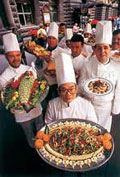 |
Food and Beverage |
 |
 |
Food and Beverage |
 |
![]()
Australian cuisine has the most diverse range, quality, and inventiveness than many others in the world. However, it took Australia some time to evolve from the scenes of meat pies, Vegemite sandwiches, and sausage rolls to the scene of dishes such as "seared kangaroo fillet with wilted beetroot greens and roasted onions". The culinary art of Australia only luxuriated in the 1990s. But at that time, it was already considered the most adventurous in the world. Each capital city has seen a swarm of new restaurants within the genre 'Modern Australia' cuisine, with inventive chefs at the helm and an audience of willing hedonists at the ready. This culinary reawakening is due to two factors: the wealth of superlative Australian produce, including native food, and the plethora of international cuisine brought to Australia by its immigrants from all over the world. (marimari.com) |

Beverages: The speed people drink alcohol beverages in Australia is amazing. This is a remain from the period when bars and pubs in Australia had to close down by 6 pm. Because most people works till 5 pm, there was only one hour left to have a few beers, so, you had to be fast. Nowadays, the speed had slow down a little bit, but not that much. Beer is the most consumed alcoholic beverage in Australia, and it must be very cold. Due the increasing quality of Australian wines and consequent drop in prices, the wine became also a very popular beverage. One of the greatest Australia inventions on packaging is the "CASK" (pictured). It is a Carton box with a tap to regulate the amount desired, with no corks to be taken out or back in. Very easy, simple and cheap. Just to have an Idea, a 4 liters Casks cost about AU$ 12, and the wine is very good. Every State in Australia have different laws about drinking and in Queensland for example, supermarkets and others can not sell alcohol, only "Bottle Shops" found in almost every corner. They are open most days from 10 am to 10 pm, 7 days a week. Restaurants, bars, pubs and some cafes can sell alcohol as soon as they have a license to do so. Some not licensed, are allowed to deal as BYO ( bring your own), so it means they don't sell alcohol, but if you bring yours from home, it is OK. The law all over Australia is very rigid for drinking and driving offences with severe penalties and even prison. Drink in public places (parks, beach, etc..) also can attract fines depending on the State you are. In Queensland the fine is AU$ 75 for the first offence. One of the most popular beers in Australia is called VB = Victoria Bitter or as my Australian friend call it, The Very Best. In Queensland, the XXXX ( four x) is very popular also, but it is weaker than the VB. The small bottles of beer are called Stubbies. The minimum drinking age is Australia is 18. (yesaustralia.com)
|
Traditional Australian Cuisine